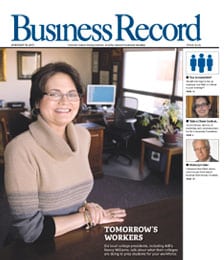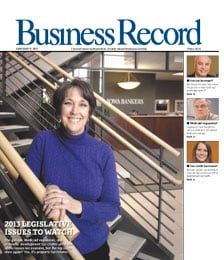A new paradigm for managing drug costs

There’s a saying that it’s best not to know too much about how sausages and laws are made. In the world of prescription drug programs, however, the more companies know about the makeup of the drug costs they’re paying for, the more they can do to control those costs, say Wellmark Blue Cross and Blue Shield officials.
On July 1, Wellmark switched its pharmacy benefit manager from Caremark to Catalyst Rx. It marks a revolutionary change in the way Iowa’s largest health insurer discloses pharmacy costs to its customers, and Wellmark expects the new system it will result in savings for its member companies.
Through the new program, called Pharmacy Insights, Wellmark plans to provide detailed drug cost information and consultation to its client companies to help them make decisions that allow costs to be reduced without sacrificing quality.
As part of the program, Catalyst Rx and Wellmark have jointly established a “Center of Excellence” at Wellmark’s downtown Des Moines headquarters, staffed by 45 pharmacy benefits specialists. Most of the center’s employees, from its medical director to its technicians, some of whom have worked behind pharmacy counters, were hired locally by Catalyst Rx.
“This is our largest Center of Excellence to date,” said Kimberly Altman, executive director of client services for the center, which will serve Wellmark customers in Iowa and South Dakota. Wellmark, which provides coverage to approximately 1.3 million Iowans, is now the largest client of Catalyst, the fourth-largest pharmacy benefit manager in the country.
Under the new arrangement, which Wellmark describes as “fully transparent,” companies will receive complete disclosure of all components of pharmacy costs, including the drugs’ wholesale costs and all fees and discounts that are applied to arrive at the bottom-line figure, said Dr. Dale Andringa, Wellmark’s chief medical officer.
By providing this information to employers and providing advice to them, “we are optimistic that costs are going to go down,” he said.
Over the past seven years, Wellmark’s pharmacy benefit cost per member, one of four key components of health-care costs it tracks, has risen 155 percent. In 1998, per-member pharmacy costs averaged $16.86 per month; in 2005, they averaged $43.06 per month.
“That rate of increase has actually come down in the last couple of years to single digits now, but we still believe there is a greater opportunity to control costs,” Andringa said. “That is why we have made a change in our model, and to be able to pass those changes along to our customers real-time.”
Self-funded plans administered by Wellmark can expect to receive rebates of premiums on a dollar-for-dollar basis quarterly, Andringa said. Fully insured individuals or groups would have any savings factored into premium reductions in the following plan year.
“If we can control (spending), the premiums will be lower,” he said.
Moving away from a “black-box” approach to pharmacy costs would be beneficial, said Dr. David Swieskowski, vice president for quality at Mercy Clinics Inc. in Des Moines. However, he remains skeptical whether Wellmark’s new approach will represent an improvement over that used by Caremark.
“In the previous plans, I could never figure out what the motivation was for what (the pharmacy benefit manager) was doing,” said Swieskowski, who serves as a board member of the Iowa Medical Society and is also on Wellmark’s physician advisory board. “They were always advising me to prescribe the more expensive drugs, and I think the motivation was they had negotiated rebates for them. My understanding is that with the Catalyst plan, there won’t be any more secrets. If there’s a rebate, everyone’s going to know about it. I find that very favorable; I don’t like having the secret stuff going on.”
Health plans don’t seem to realize that complying with each request to change a patient’s medication to save money costs the physician in terms of administrative costs, Swieskowski said. Having more open cost information is a start, he said, but “somehow, they have to figure out how to give us an incentive, other than just doing the right thing. We are constantly requested to do unreimbursed services because they are the right thing. If we did all of these, we’d go broke.”
Nancy Roehrkasse, human resources director for Des Moines-based Communications Data Services Inc., a Wellmark customer, said she is uncertain at this point what the program may mean for her company.
“Any information that they can provide us to help us manage this product, the better off all of us are going to be,” said Roehrkasse, whose magazine subscription fulfillment company employs 2,500 people in Iowa. “Six months from now, we’ll know whether they did what they said they’re going to do. I do admire Wellmark for taking this step, because it’s a big one.”
The bulk of the consulting services will be targeted to employers with more than 100 workers. Wellmark officials said the analysis that Catalyst can provide for smaller companies will be limited by the data it can provide without compromising the privacy of individual insured members.
Catalyst’s approach in establishing a local presence with its Center of Excellence is unique to the pharmacy benefit management industry, according to Peter Roberts, Wellmark’s group vice president for provider relations and health management.
“Most large (pharmacy benefit managers) have a few offices around the country, and they fly their experts in to local markets on a periodic basis,” he said in a recent issue of the company’s quarterly magazine, BlueReview. “With the Center of Excellence, however, the experts are here year-round to build relationships with employers, physicians, pharmacists and Wellmark staff.”
The center, which is already fully staffed, includes account managers, information technology specialists and benefits specialists working with Dr. Stephen Richards, whom Catalyst has hired as its on-site medical director. Richards, an Algona osteopath, is past president of the Iowa Medical Society and serves on its board.
Under the plan, covered employees will have access to drug information by registering on Wellmark’s Web site at www.wellmark.com. Using the site, they will be able to find out what their co-payment would be for specific prescriptions at their pharmacy or to look up generic alternatives to name-brand drugs.
Catalyst is part of HealthExtras Inc., a publicly traded company based in Rockville, Md. Catalyst currently manages pharmacy plans for more than 3.5 million members in all 50 states. HealthExtras has forecast 2006 revenues of more than $1.2 billion and net income of $33.5 million, which would be a 45 percent increase over 2005.
Because Wellmark will collect a fixed monthly administrative fee from each company enrolled in the plan, Catalyst will not have an incentive to encourage more claims to boost its income, said Wayne Knisley, Wellmark’s director of pharmacy. Catalyst is not owned by or affiliated with drug manufacturers, and does not own a mail-order drug company, so it has no incentive to push mail-order services as a way to increase profits, he said.
“Under the traditional [pharmacy benefit manager] model, the more drugs dispensed, the more they get paid,” he said.







